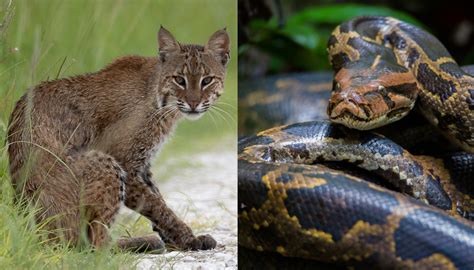
A bobcat was caught on camera dispatching a Burmese python in a dramatic encounter in the Florida Everglades, biting off the snake’s head in a rare and visceral display of predator versus prey.
A visitor at Everglades National Park captured the startling moment when a bobcat was seen engaging with, and ultimately killing, a Burmese python. The encounter, highlighting the ongoing struggle between native wildlife and invasive species, unfolded in broad daylight and was recorded by park visitor, whose video has since gone viral, illustrating the intense interactions occurring within the Everglades ecosystem.
The footage shows the bobcat initially cautiously approaching the snake before engaging in a fierce battle. The bobcat is then seen clamping down on the python’s head, ultimately severing it. Experts note that this event is a stark illustration of the efforts by native species to control the invasive python population, which has been devastating for the local ecosystem.
Burmese pythons are one of the most concerning invasive species in Florida, having established a significant presence in the Everglades and surrounding areas. These snakes, native to Southeast Asia, pose a grave threat to native wildlife, as they consume a wide variety of mammals, birds, and reptiles. Their introduction is largely attributed to the exotic pet trade, with escaped or released individuals establishing a breeding population.
The Florida Fish and Wildlife Conservation Commission (FWC) has implemented various measures to manage the python population, including encouraging the public to report sightings and participate in python removal programs. Hunters are incentivized through competitions and other initiatives to capture and remove pythons from the wild. The FWC also collaborates with researchers to explore innovative control methods, such as using detection dogs and developing traps specifically designed for pythons.
The bobcat’s successful predation on the python serves as a reminder of the complex ecological dynamics at play within the Everglades. While not a common occurrence, native predators occasionally manage to kill and consume pythons, providing a small degree of natural control. However, experts emphasize that the scale of the python invasion far outweighs the impact of individual predation events, underscoring the need for continued and intensified management efforts. The Everglades ecosystem continues to suffer due to the imbalance introduced by these invasive snakes, making control measures critical to preserving biodiversity.
The incident has sparked renewed interest in the ongoing battle against invasive species in Florida and the role that native predators might play in mitigating their impact. While the bobcat’s actions are a natural occurrence, they also highlight the larger problem of invasive species disrupting ecosystems and the need for comprehensive management strategies.
The presence of Burmese pythons in Florida dates back several decades, with the first confirmed sightings occurring in the late 20th century. Since then, their population has exploded, leading to significant declines in native mammal populations in certain areas of the Everglades. Studies have documented drastic reductions in the numbers of raccoons, opossums, bobcats, and other species, directly linked to python predation. The pythons’ ability to consume large prey items, combined with their high reproductive rate and cryptic behavior, makes them particularly difficult to control.
The FWC has established a Python Action Team, composed of trained professionals who actively search for and remove pythons from the wild. These teams utilize various techniques, including road cruising, airboat surveys, and the use of trained detection dogs, to locate and capture pythons. The captured pythons are humanely euthanized, and data is collected on their size, weight, and diet to inform ongoing research and management efforts. The Python Elimination Program pays individuals to hunt pythons on designated state lands, providing a financial incentive for python removal.
The University of Florida and other research institutions are actively involved in studying the ecology and behavior of Burmese pythons in Florida. These studies aim to better understand the pythons’ habitat preferences, movement patterns, and diet, as well as to evaluate the effectiveness of different control methods. Researchers are also exploring the potential for using biological control agents, such as viruses or parasites, to target pythons specifically. However, the use of biological control agents is a complex and controversial issue, requiring careful evaluation to ensure that they do not pose a threat to native species.
The Everglades National Park, a vast and ecologically significant wetland ecosystem, is particularly vulnerable to the impacts of invasive species like the Burmese python. The park provides a refuge for a wide array of native plants and animals, many of which are found nowhere else in the world. The introduction of pythons has disrupted the delicate balance of the Everglades ecosystem, threatening the survival of many native species. Park officials are actively involved in python control efforts, working in collaboration with the FWC and other partners to protect the park’s natural resources.
The bobcat-python encounter serves as a powerful reminder of the interconnectedness of species within an ecosystem. While the bobcat’s actions may provide a small degree of natural control, the overall impact of pythons on the Everglades ecosystem remains significant. The ongoing efforts to manage and control the python population are essential for preserving the biodiversity and ecological integrity of this unique and valuable natural area. The event also brings attention to the broader issue of invasive species management and the need for continued vigilance and proactive measures to prevent the introduction and spread of harmful non-native species. Public awareness campaigns, stricter regulations on the exotic pet trade, and increased funding for research and control efforts are all critical components of a comprehensive strategy to address the challenge of invasive species in Florida and beyond.
The viral video of the bobcat killing the python has also sparked a broader discussion about the ethics of intervening in natural events. Some argue that humans should not interfere with natural processes, even when those processes involve invasive species. Others contend that humans have a responsibility to mitigate the negative impacts of invasive species, particularly when those species were introduced as a result of human activities. This debate highlights the complex ethical considerations involved in wildlife management and conservation. Ultimately, decisions about how to manage invasive species must be based on a careful assessment of the ecological, economic, and social impacts, as well as ethical considerations.
Further expanding on the implications of this event, it is essential to consider the long-term effects of the Burmese python invasion on the genetic diversity of native species. As python predation continues, native populations may become more fragmented and isolated, leading to a loss of genetic variation. This can make them more vulnerable to disease, environmental changes, and other threats. Conservation efforts must therefore focus not only on reducing python numbers but also on maintaining the genetic diversity of native populations. This may involve translocation of individuals between populations to increase gene flow or the establishment of captive breeding programs to preserve genetic diversity.
The economic costs associated with managing invasive species like the Burmese python are also substantial. The FWC spends millions of dollars each year on python control efforts, research, and public education. These costs are borne by taxpayers and could be used for other important priorities, such as education, healthcare, or infrastructure. The economic impacts of invasive species extend beyond direct management costs, however. They also include losses to agriculture, forestry, and tourism. For example, python predation can reduce populations of game animals, impacting hunting opportunities and tourism revenue. Invasive plants can displace native vegetation, reducing the value of forests for timber production and recreation.
Addressing the challenge of invasive species requires a collaborative approach involving government agencies, research institutions, private landowners, and the public. The FWC works closely with other agencies, such as the National Park Service and the U.S. Fish and Wildlife Service, to coordinate python control efforts across different jurisdictions. Research institutions play a vital role in providing scientific information to inform management decisions. Private landowners can help by removing pythons from their property and implementing habitat management practices that reduce the suitability of their land for pythons. The public can contribute by reporting python sightings, participating in python removal programs, and educating themselves about the impacts of invasive species.
The bobcat-python encounter, while a dramatic and compelling event, represents just one small piece of a much larger and more complex puzzle. The challenge of managing invasive species in Florida and around the world requires a sustained and coordinated effort involving multiple stakeholders and a commitment to using the best available science to inform management decisions. The future of the Everglades ecosystem, and the many species that depend on it, hinges on our ability to effectively address this challenge.
To emphasize the complexity, it’s important to note that the complete eradication of Burmese pythons from Florida is likely impossible given their established presence and reproductive capabilities. The focus, therefore, is on control and containment to minimize their impact on native wildlife and ecosystems. This involves a multi-pronged approach, including active removal, research into new control methods, and public awareness campaigns.
The use of technology is also playing an increasingly important role in python control efforts. Researchers are experimenting with the use of drones equipped with thermal cameras to detect pythons in dense vegetation. These drones can cover large areas quickly and efficiently, providing valuable information on python distribution and abundance. GPS tracking devices are also being used to monitor the movements of individual pythons, helping researchers to understand their habitat preferences and movement patterns.
The Everglades is not the only area in Florida affected by invasive Burmese pythons. They have also been found in other parts of the state, including urban areas. This poses a challenge for control efforts, as pythons in urban areas may be more difficult to detect and remove. Public education campaigns are particularly important in urban areas, as residents may be more likely to encounter pythons and need to know how to report sightings and avoid interactions.
The impacts of Burmese pythons extend beyond direct predation on native wildlife. They can also compete with native predators for food resources, disrupt food webs, and alter habitat structure. For example, pythons may compete with native snakes, such as cottonmouths and rattlesnakes, for prey. They can also reduce populations of small mammals, which are important food sources for other predators, such as owls and hawks.
The bobcat-python interaction offers an opportunity to discuss the broader ecological context of predator-prey relationships and the role they play in maintaining ecosystem health. In a healthy ecosystem, predator and prey populations are typically regulated by natural processes, such as competition, disease, and environmental fluctuations. However, the introduction of invasive species can disrupt these natural processes, leading to imbalances and declines in native populations. The python invasion has essentially added a super-predator to the Everglades ecosystem, disrupting established food webs and putting native species at risk.
The encounter also sparks reflection on the role of humans in altering ecosystems. The introduction of Burmese pythons to Florida is a direct consequence of human activities, specifically the exotic pet trade. This underscores the importance of responsible pet ownership and the need for stricter regulations on the importation and sale of exotic animals. Preventing the introduction of new invasive species is far more cost-effective and ecologically sound than attempting to control established populations.
The story of the bobcat and the python has captured the public’s attention, raising awareness about the challenges of invasive species management and the importance of protecting native ecosystems. This increased awareness can translate into greater support for conservation efforts and a more informed public that is better equipped to make responsible choices that minimize their impact on the environment. The event serves as a compelling reminder of the power of nature and the interconnectedness of all living things. It also highlights the urgent need to address the global problem of invasive species, which threatens biodiversity and ecosystem health worldwide.
The FWC encourages the public to report any sightings of Burmese pythons or other invasive species. Reports can be made online through the FWC’s website or by calling the Exotic Species Hotline. The FWC also offers educational resources for landowners and the public on how to identify and manage invasive species. The continued vigilance and participation of the public are essential for the success of invasive species management efforts in Florida.
In the aftermath of the viral video, discussions about conservation strategies have intensified, focusing on both short-term and long-term solutions. Short-term solutions involve continued efforts to remove pythons from the wild, utilizing various methods such as trapping, hunting, and detection dogs. Long-term solutions focus on preventing future introductions of invasive species, developing more effective control methods, and restoring degraded habitats.
The bobcat’s bold action against the python is a testament to the resilience of native species and their ability to adapt to changing environmental conditions. However, it is important to recognize that individual acts of predation are not sufficient to control the python population. A comprehensive and sustained effort is needed to address the challenge of invasive species and protect the biodiversity of the Everglades ecosystem.
The discussion extends to the global implications of invasive species. Many countries around the world are grappling with the impacts of non-native species on their ecosystems and economies. The lessons learned from Florida’s experience with Burmese pythons can inform management strategies in other regions facing similar challenges. International collaboration and information sharing are essential for preventing the spread of invasive species and protecting global biodiversity.
The bobcat-python encounter, therefore, represents a microcosm of a larger global problem. It highlights the interconnectedness of ecosystems, the impact of human activities on the environment, and the need for collaborative solutions to address the challenge of invasive species. The story serves as a call to action for individuals, communities, and governments to take responsibility for protecting the planet’s biodiversity and ensuring the health of its ecosystems.
Frequently Asked Questions (FAQ)
1. What happened in the Everglades involving a bobcat and a python?
A bobcat was observed and filmed preying on a Burmese python in Everglades National Park. The bobcat killed the python by biting off its head. This event highlights the interaction between native wildlife and invasive species within the Everglades ecosystem.
2. Why are Burmese pythons considered a problem in Florida?
Burmese pythons are an invasive species in Florida, primarily in the Everglades. They are a threat to native wildlife because they prey on a wide range of mammals, birds, and reptiles, leading to declines in native populations. They compete with native predators and disrupt the natural food web.
3. What measures are being taken to control the Burmese python population in Florida?
The Florida Fish and Wildlife Conservation Commission (FWC) has implemented various measures, including encouraging public reporting of sightings, incentivizing python removal through programs and competitions, collaborating with researchers to develop innovative control methods (such as detection dogs), and maintaining Python Action Teams to actively search for and remove pythons.
4. Can native predators, like bobcats, effectively control the python population?
While native predators occasionally kill and consume pythons, providing a small degree of natural control, the scale of the python invasion far outweighs the impact of individual predation events. Continued and intensified management efforts are crucial to manage the python population effectively.
5. How can the public help with python control efforts in Florida?
The public can assist by reporting any python sightings to the FWC, participating in python removal programs, educating themselves about invasive species, and supporting policies and initiatives aimed at managing and controlling invasive species populations. The FWC offers online resources and an Exotic Species Hotline for reporting sightings and learning more about invasive species management.









